This season of the Bundesliga has unpacked no short of excitement with many big names challenging each other not just for the top spot, but also for a place that would gain them an advantage in the race for European football. Rather than the familiar scenario of Bayern München dominating the league, the likes of Borussia Mönchengladbach, Borussia Dortmund or RB Leipzig are now rotating among each other for the top of the league. The race for a spot in the European competitions next season also brings excitement as the gap between teams is quite small.
Last weekend, two of the teams running for a place in the top six, Schalke 04 and Eintracht Frankfurt, met each other in what was considered an interesting match in terms of both teams’ tactics. The home side, who was managed by former Huddersfield Town manager David Wagner, were sat in fourth place before the match as they hoped to secure a positive result that allowed them to be in a more positive state to return to the Champions League. Meanwhile, last season Europa League semi-finalist, Frankfurt, had a struggling start to the season as they found themselves sitting 12th before this match. Still, Adi Hütter and his players hoped their visit to the Veltins-Arena would bring them three points to improve their place in the league table.
It is fair to say that Frankfurt had a decent match as they neutralised Schalke’s attacking force on several occasions. But just one moment of a counter-attack from the home side put them on the back foot as Benito Raman secured the winning goal for Schalke. This tactical analysis will provide an analysis of Schalke’s 1-0 win over Frankfurt. Meanwhile, using statistics, we will point out the noticeable tactical points in both Hütter’s tactics and Wagner’s tactics.
Lineups
Entering this match, Wagner opted to line his side up in a familiar 4-4-2 formation as Alexander Nübel continued to be the first choice in goal. At the heart of Schalke’s defence, the team would miss the service of Matija Nastasić as he continued to be ruled out after missing the trip to Leverkusen, while Salif Sané and Benjamin Stambouli remained on the team’s treatment list. This left the German manager no choice but to use Weston McKennie as a centre-back alongside Ozan Kabak and they completed the back-four that had Bastian Oczipka playing as left-back and Everton loanee Jonjoe Kenny occupied a similar role on the opposite flank.
The team were also left without the service of former Hoffenheim striker Mark Uth since he was still recovering from his injury. Youngster Ahmed Kutucu was a doubt before the match and also didn’t make the eventual squad list. Thus, the front three that Wagner used for this match consisted of striker Benito Raman, who received support from attacking midfielder Amine Harit and the two wingers in Daniel Caligiuri and Rabbi Matondo.
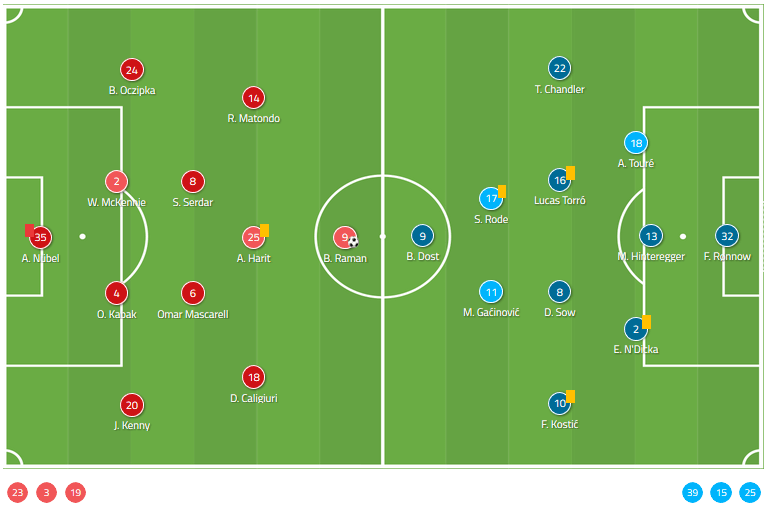
Meanwhile, Frankfurt also experienced a similar situation to Schalke’s as Hütter was left without too many options to form his back-three. Firstly, captain David Abraham continued to serve his domestic ban and would obviously be ruled out from the match squad. Another option that could’ve also been used as a centre-back in Dominik Kohr was also suspended for this match. Therefore, former Monaco defender Almamy Touré was chosen to fill in the last centre-back spot alongside Martin Hinteregger and Evan N’Dicka.
Lucas Torró managed to recover from his illness and returned to the lineup as he paired up alongside former Young Boys midfielder Djibril Sow. Up front, Bas Dost finally made a return but his situation was still being monitored before the match. Still, he was chosen to play as the team’s leading striker. On the bench, Hütter had many interesting offensive options to pick from, such as Japanese attacking midfielder Daichi Kamada, or the Portuguese striking duo André Silva and Gonçalo Paciência alongside several defensive choices in veteran Makoto Hasebe or Simon Falette.
Frankfurt’s offensive strategies
It has become a familiar scene to see Frankfurt playing out from the backline since they had three centre-backs who were comfortable with the ball at their feet and able to make penetrative passes up front. Especially with Hinteregger and N’Dicka, they had two excellent ball-playing defenders who could take on the responsibility of linking up with the midfielders and progressed the ball up the field.
In order to do so, these three tended to position themselves a bit higher inside the team’s half and created a passing triangle among themselves. There were times they also opted to stretch the triangle with the French defenders moving into the half-spaces to gain time and space under the pressure of Schalke’s attackers. But, during most occasions, they would be receiving support from Torró, who was willing to drop deeper to bring the ball out of defence as he could distribute it forward to the likes of Sebastian Rode or Mijat Gaćinović.
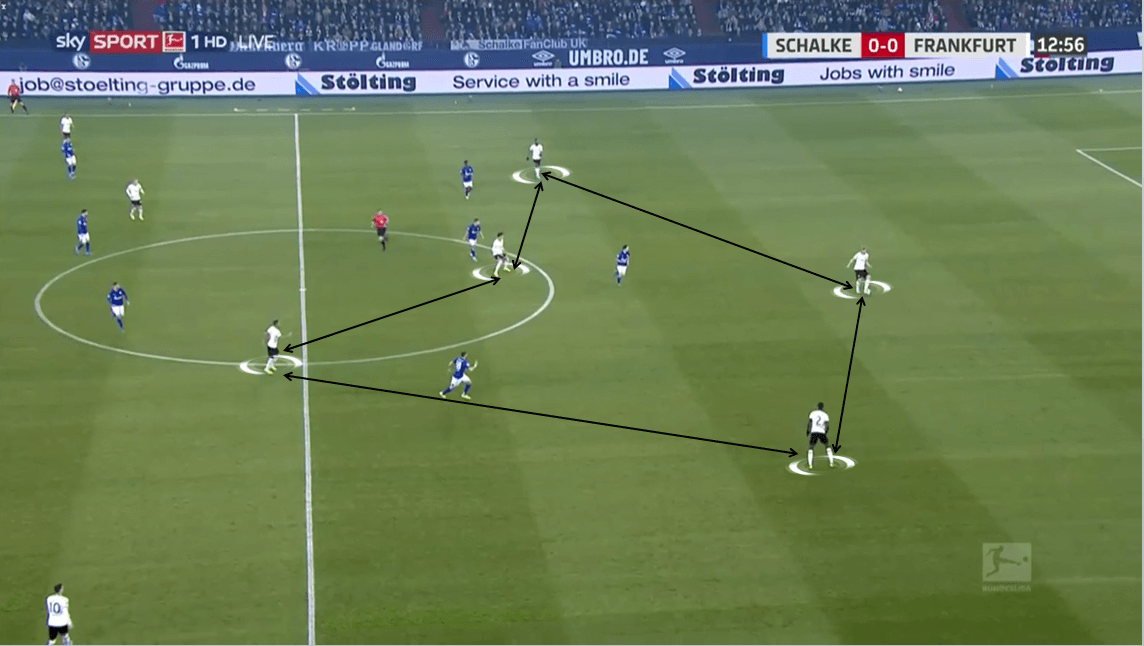
The decision to use Touré over Hasebe looked a bit interesting as his preferred position was a full-back rather than being a centre-back. But he gave the back-line more pace from his style of play as his flexible movements helped the three defenders connect to the players up front more easily. Furthermore, it was viable for him to pick up the ball from his teammates and then drive forward to give Frankfurt another attacking option. While they still had Timothy Chandler stretching Schalke’s defensive shape, Touré would dribble with the ball forward through the gaps that were opened by Chandler and lay the ball to the attacking players.
Also, it is worth noticing that Frankfurt were a wing-oriented team during the match. It doesn’t come as a surprise, though, given the fact that they tended to rely on the crosses that were put into the box by Chandler from the right flank and Filip Kostić on the opposite wing. With 25 crosses being attempted during the match, they were the more superior team in terms of this compared to Schalke’s record of only ten.
The physicality of Dost was also useful in this strategy in a significant way as he was able to turn up at the end of crosses on a day that Schalke had to count on Kabak heavily to deal with those aerial duels. Statistically speaking, the Dutch striker registered 17 aerial duels in the game, the highest number compared to both teams’ players, and completed eight of them.
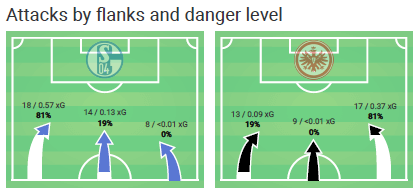
One of the reasons that allowed the visitor to have more time on the ball out wide was Schalke’s narrow defensive shape. During several of their transitioning processes, the home side created a narrow block in front of the ball carrier with the aim of preventing through passes and long balls being made into the final third. Given the fact that their players were able to retreat back into their half quickly, it was possible for Schalke to maintain numerical superiority during the phase.
But with Frankfurt opting to distribute the ball down both flanks, it was expected of Kostić and Chandler to be involved much in their attacking scenarios. They would make overlapping runs up the pitch and offered to pick up the ball out wide, similar to the shot below. This gave Frankfurt players the opportunity to position themselves in a good area while Chandler was still receiving the ball and Schalke’s defensive shape shifted across the field again. There, a cross would be made into the box in order to find the head of Dost, Rode or even Kostić himself.
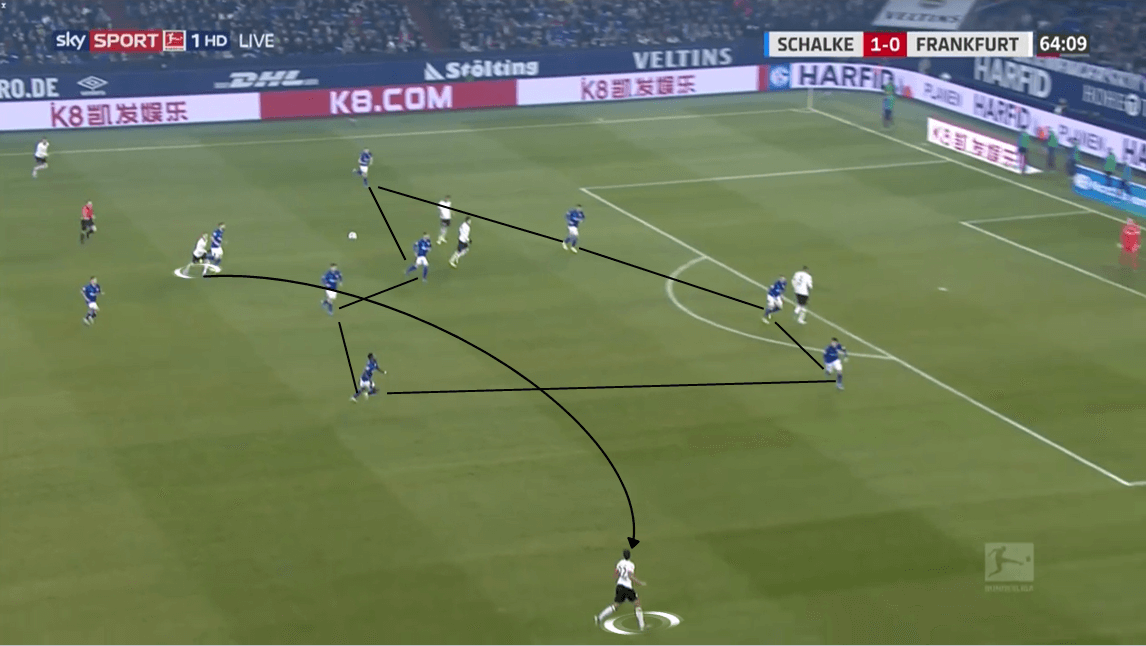
Still, that wasn’t the only attacking option that Frankfurt went with to distribute the ball up into the opposition’s half. Directly from the build-up phase, the central midfielders could opt to use long balls to find the run of the attacking players. Since Schalke occasionally pressed high up the pitch, they had to push their defensive line up to support the process.
This left the space behind their back unoccupied and Gaćinović was able to capitalise as he made good use of his pace to pick up the through ball from his teammate, similar to the shot below. Again, although they were able to break on several occasions, Schalke players were quick enough to retreat into their half and prevented the counter-attack.
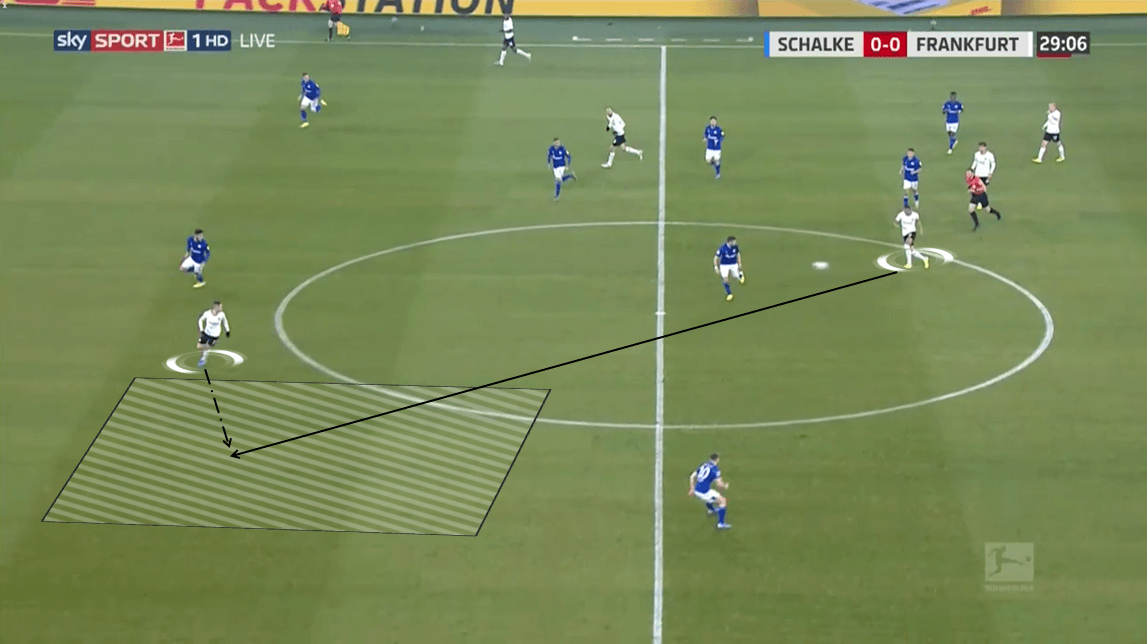
While Frankfurt’s attacking strategies looked ideal and many expected it to help them to create several dangerous chances towards Nübel’s goal, their biggest problem was, surprisingly, in creating and converting chances. During the period from the first minute to the 35th minute, their xG recorded was almost at 0. This shows they were struggling in terms of threatening Schalke’s goal amid the fact that the build-ups towards several of those chances were pretty decent.
Another stat that showed how Frankfurt were struggling with creating chances is their highest xG-rated player. Surprisingly, that player was Touré as his header in the 39th minute was rated at 0.25 xG and, therefore, made him the highest xG-rated player among the squad and the highest xG-rated chance. They found it hard to progress the ball into the final third and was forced to create chances from outside the box, with seven of them eventually going wide.
Schalke’s style of play
One of the reasons behind Frankfurt’s attacking struggle was the discipline of Schalke’s defensive shape. Up front, the home side attempted to apply pressure on the visitor’s build-up phase using their man-oriented marking strategy. With one player following one of Frankfurt’s defenders, they aimed to eliminate passing lanes and links being created by the ball carrier and forced him to play a long ball up front. While the press remained conservative, it still proved to be efficient as Frankfurt defenders occasionally found themselves suffocated since they weren’t able to connect with Torró and Sow to progress the ball forward.
Furthermore, they also received the support from both central midfielders Omar Mascarell and Suat Serdar since these two tended to push up and mark Frankfurt’s midfielders at the same time. They could also move flexibly and stretched wide to prevent the centre-backs from making passes that headed towards Chandler or Kostić.
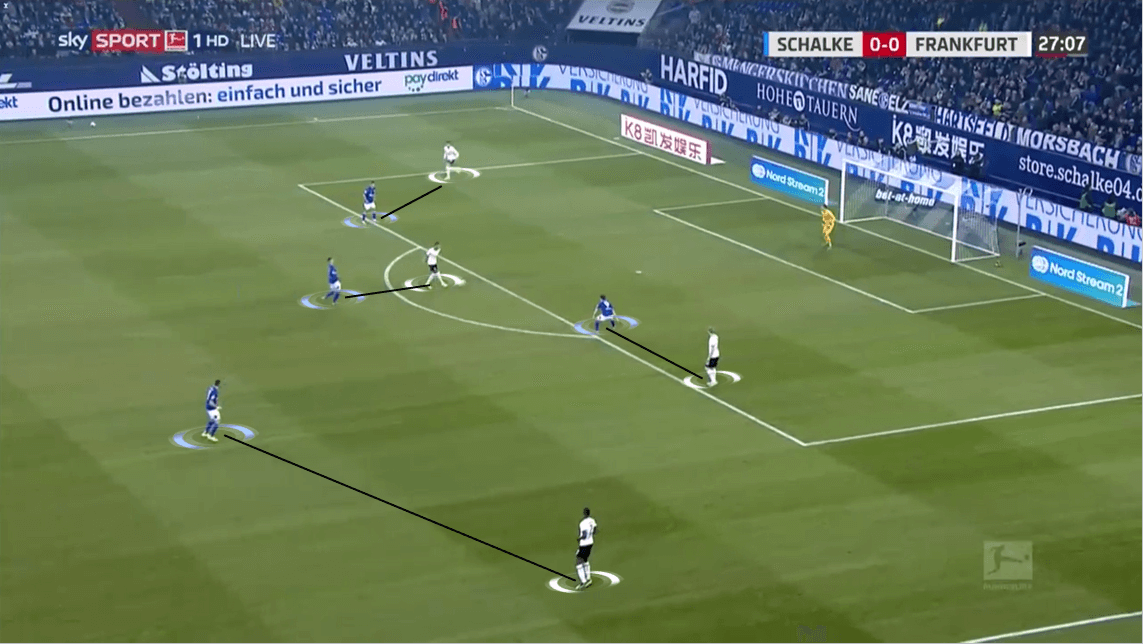
In this phase, their body orientation played a key role in helping them intercep passes directly inside the opposition’s half. In the shot below, Raman and Caligiuri chose a good position to put themselves in as they blocked the possibility of N’Dicka making a pass towards one of his teammates. Since he had no choice in that situation, a back pass was executed to Frederik Rønnow and it was cleared up front.
During situations where the press was bypassed, Schalke players would quickly form a 4-4-1-1 defensive shape inside their half, which can also be seen as a 4-4-2 when Harit pushed higher to support Raman in the press. With two distinctive defensive lines, it was possible for Schalke players to create a mid-block inside their half and also prevented Frankfurt attackers from bursting into the space behind their backs using an offside trap.
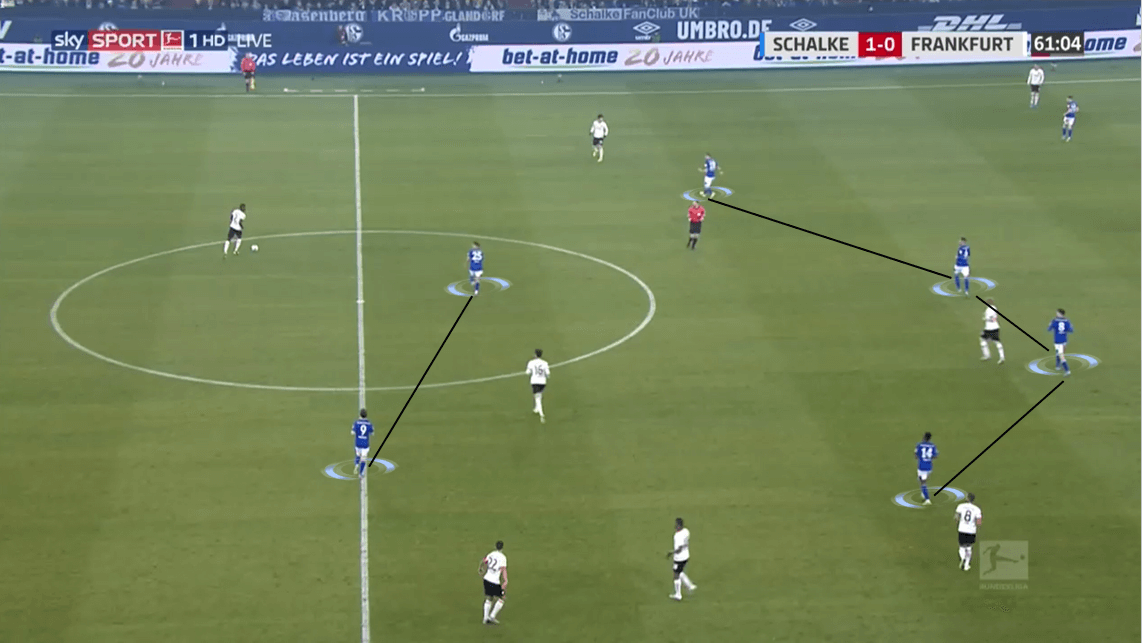
Even when Nübel was sent off, Wagner still insisted on keeping their 4-4-2 defensive shape by subbing Harit off for Markus Schubert but not a defender or a midfielder. After the red card, their defensive shape was even more disciplined in keeping things tight at their end and they tried to keep the gap between the lines as narrow as possible to prevent Frankfurt attackers from capitalising on it.
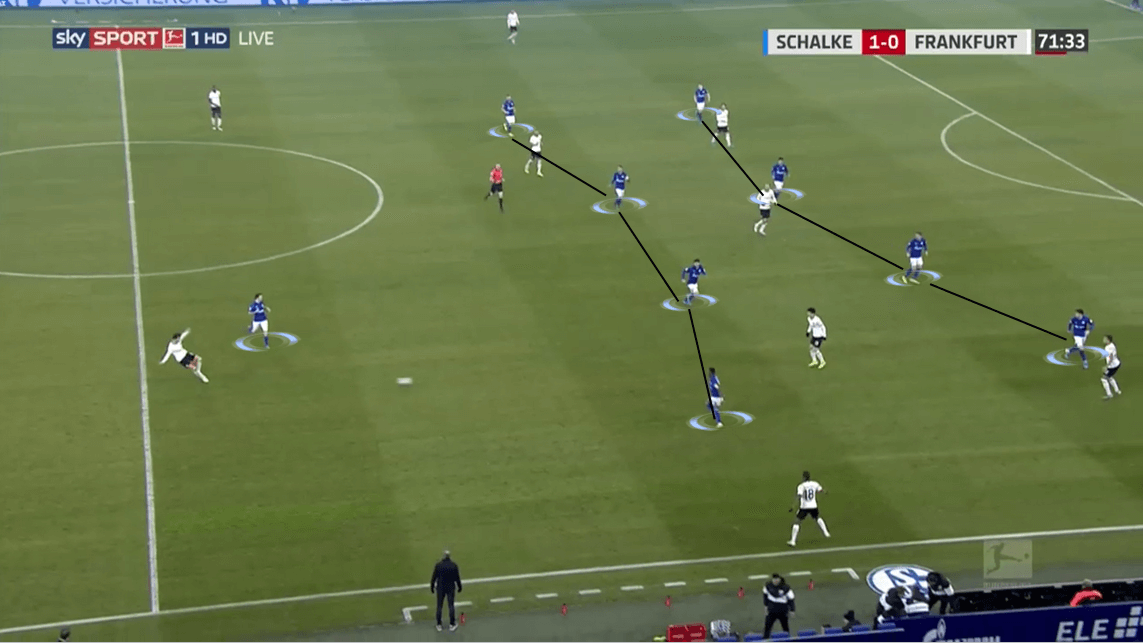
Mascarell’s role in Schalke’s tactics was quite crucial both on and off the ball. Defensively, he occasionally played as a pivot who screened the space in front of the defensive line and intercepted passes that came towards them. At times, it was viable for him to drop in between Kabak and Oczipka to form a back-five but that scenario was not being implemented too often. Offensively, he also moved centrally and split Kabak and Oczipka out to create a three-man build-up.
While at Frankfurt, he was also deployed in a similar way by Niko Kovač to create a passing block inside their half. But since they already lined up with a back-three, it was not necessary for the former Real Madrid midfielder to drop in between the centre-backs. At Schalke, though, he used his passing ability to bring the ball out of defence as he occupied the central area while, in this case, Kabak and Oczipka took on both half-spaces.
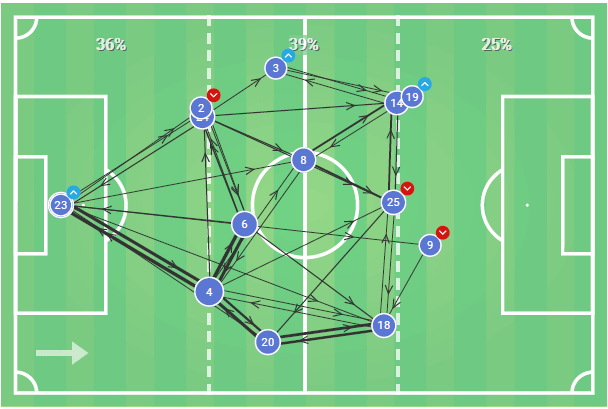
Similar to how the opposition built their attacks, the players aimed to create a passing block inside their half and positioned themselves a bit higher to link up with the attackers. But with Mascarell dropping into the defence, Serdar now occasionally paired up alongside Harit as two midfielders who took on the responsibilities of receiving passes from the defenders and drove forward to connect with the attacking players while also bringing them into play.
Before McKennie left the field due to an injury, Oczipka was the player who filled in Harit’s place and allowed the Moroccan midfielder to stay forward. The former Frankfurt left-back was converted to a centre-back when McKennie was subbed off and Barcelona loanee Juan Miranda took on the attacking left-back role for the rest of the match.
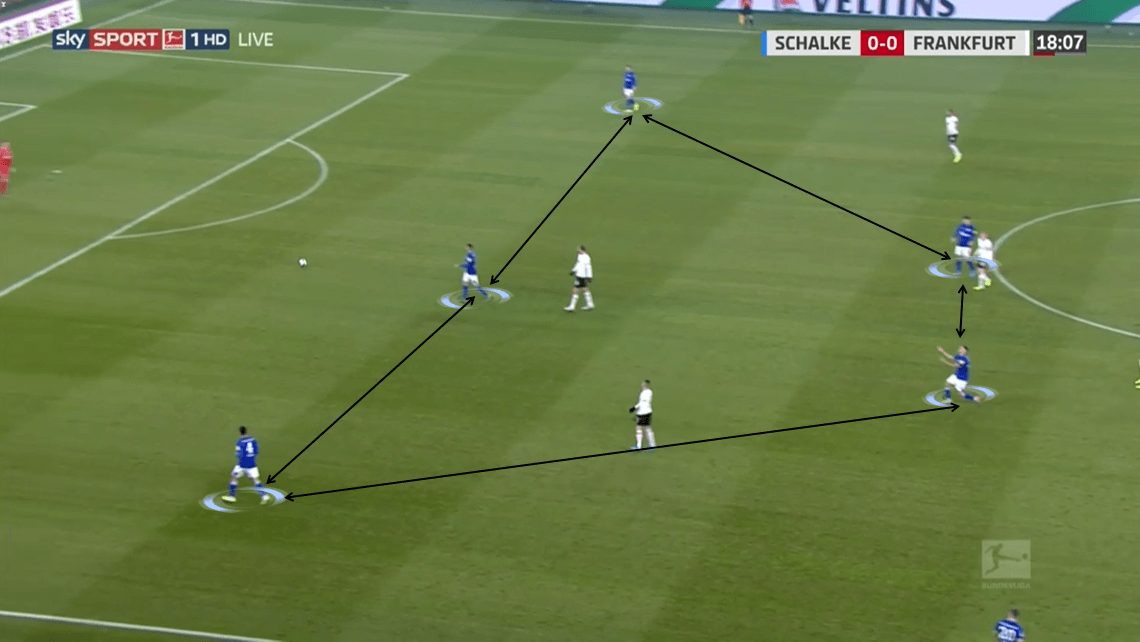
But the thing that helped Schalke reach a higher completion rate in their build-up was their intention of moving the ball quickly. Frankfurt also pressed and they even pressed in a more aggressive way compared to Schalke, but the player’s positioning and being able to circulate the ball in a quick fashion allowed the home side to bypass the press.
Another thing that can be noted from Schalke’s build-up was the thought of using two central midfielders to lure Frankfurt’s midfielders to move forward. As mentioned, Harit and Serdar usually stayed deep to form a passing block alongside the defenders and this forced Torró and Sow to move high up and mark them due to the fact that three of their attacking players already marked Schalke’s defenders. This benefitted the attackers as it allowed them to capitalise on the space between the defensive line and the midfielders.
Especially when both wing-backs overlapped up the pitch, Caligiuri and Matondo would cut inside and lavet the wide space for Kenny and Miranda to enter the opposition’s final third. That was where they could receive long passes that were made by either Kabak or Oczipka and continued the team’s attack in the quickest way possible. Both of the wing-backs had the pace to overlap up the pitch and combined with the passing ability of two centre-backs, it allowed them to receive the ball in the easiest way and continue the team’s attack.
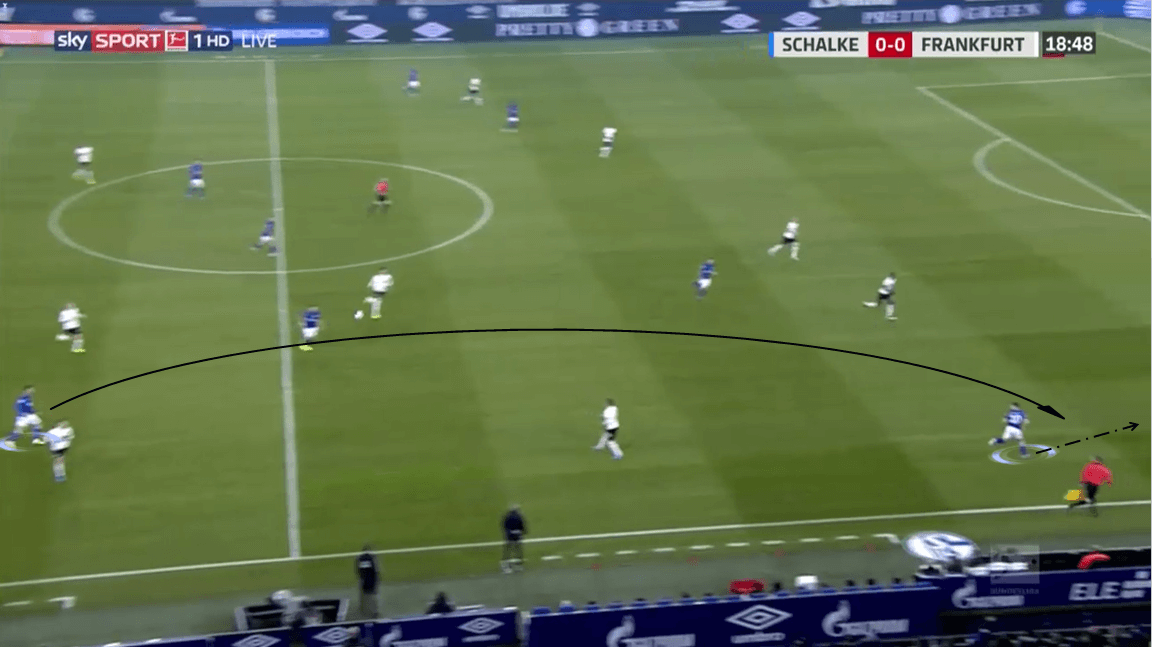
But it wasn’t how Schalke got their winning goal of the game, though. It was from a pressing situation where Mascarell and Matondo attempted to win the ball back from Touré, and they did. Mascarell’s pass put both Harit and Raman in a 2v1 situation since Caligiuri’s movement already pinned down N’Dicka. It was the former Fortuna Düsseldorf’s movement that really caught the eye in the situation that led to the goal.
He immediately noticed the gap in between N’Dicka and Hinteregger right after possession was recovered and intelligently drifted wide to attract the attention of the Austrian defender. At the same time, Harit capitalised on that by moving into that gap and when Hinteregger made a round run to turn his body towards Raman, a pass was already made into his blindside and there was nothing he could do to stop the Belgian striker from scoring the decisive goal.
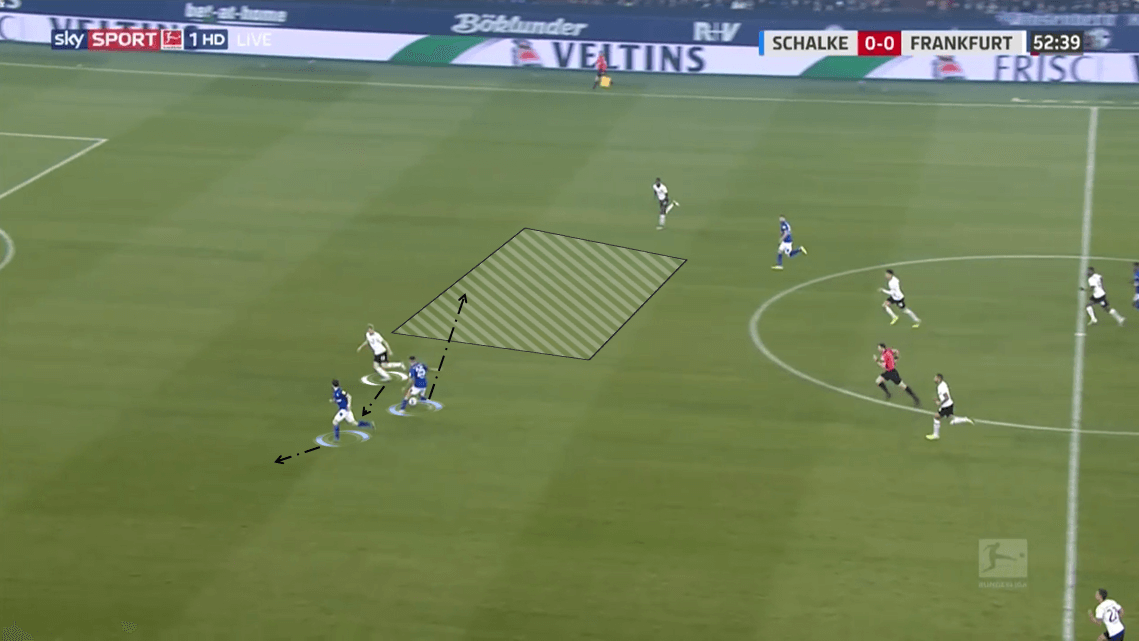
Conclusion
It is hard to argue that this match was a great tactical battle between two masterminds on the sideline. Both Wagner and Hütter deployed interesting tactics for their sides with distinctive principles that allowed them to enjoy their successful spells. But eventually, this match ended up with only one winner and it was the team who managed to seize the chances that they had. Schalke can consider this as momentum to push for their return to the Champions League, but given the fact that the season is still far from over, they need to be consistent in their tactics.
For Frankfurt, it hasn’t been such a good spell for them since their 5-1 win over Bayern München. With only one point picked up from a possible fifteen points, the hope of returning to Europa League or even progressing further is becoming a bit unrealistic for them this season. But, again, the season is still far from complete and what Hütter and his team need to do is to sit down, work out the issues that they are currently facing. And besides, the winter transfer window is getting closer.

If you love tactical analysis, then you’ll love the digital magazines from totalfootballanalysis.com – a guaranteed 100+ pages of pure tactical analysis covering topics from the Premier League, Serie A, La Liga, Bundesliga and many, many more. Buy your copy of the December issue for just ₤4.99 here





Comments